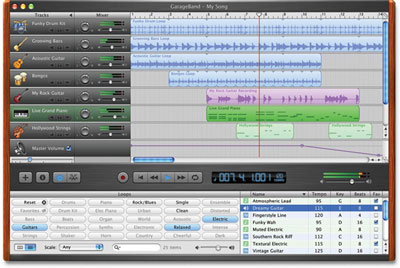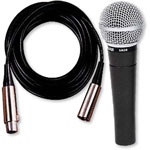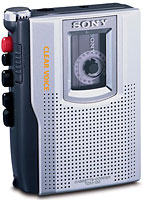The problem with synthesisers, Brian Eno once remarked,
is that musicians waste hours scrambling through the electrons
for a new sound, when it's clear that what they're actually
looking for is a new idea. Sit them down at a grand piano
and that same musician will focus instead on the notes
they're supposed to be playing. But then digital technology's
like that. It may make tasks many times easier to achieve,
but simultaneously it's many times easier to get distracted
from the job in hand.
We all fall for it. The Great Lie that if we only added
this or that alluring new upgrade, our working lives would
be so much more productive we'd have loads more free time
to spend chilling out with our loved ones. As if.
Over the years, messrs Steinberg, MOTU, Digidesign and
others have periodically persuaded me to part with hundreds,
maybe thousands of pounds in pursuit of that Lie. I've
wasted not only money but whole working weeks that could
have been usefully spent with pen, paper and a cassette
recorder - trying to synchronise MIDI, or cajole some
temperamental bit of kit into letting me even begin my
working day.
I've stared in bewilderment at screens cluttered with
enough windows, buttons and icons to fly a jumbo jet.
I've fiddled for hours with Over-Easy compression, Parametric
EQ, and infinitesimal degrees of quantization instead
of getting on with the song I was supposed o be writing.
And every few months I've ended up ditching the whole
digital disaster and going back to good old analogue tape.
Secondhand copy of Cubase anyone ?
And then, out of the blue, came GarageBand.
It's thirty years since I started making music for a living
- and nearly twenty since I bought my first Mac. I've
lived through Elvis, the Beatles, Flower Power, Glam,
Punk, Rap, House, Hiphop and Britpop. In that time the
technology of music has changed beyond all recognition.
But trust me. There's never been anything quite like GarageBand.
Garageband is to Protools etc what the model T Ford was
to the early Bentley. Technically inferior perhaps, but
mass produced, easy to use, cheap to maintain, and a tenth
of the price. The technology had existed in the hands
of a privileged elite for years. It took Henry Ford to
make it attractive and accessible for the Great Unwashed.
And no doubt the motoring experts of the day turned up
their noses at the Model T, just as Cubase snobs sniff
at GarageBand today. It isn't a "proper" music
application, they sneer: it's for amateurs to "mess
about" with.
But "messing about" is the whole point: inspiration
springs not from professionalism but spontanaeity and
playfulness. As for not being a "proper" application,
Garageband may have its quirks and shortcomings, but a
penniless Prodigy or the next Missy Elliott could easily
work around them. Thanks to Apple's acquisition of Emagic
there's enough thoroughbred horsepower under the hood
to coax 100% professional results from this astonishing
little package. The floundering Music Industry is so desperate
for anything genuinely fresh and original that any bona
fide teen genius could bang out a couple of demos in Garageband,
give them away free on the web and wait for the world
to beat a path to their door.
But if you're considering a venture of your own into musicmaking
on a Mac, take a tip from your Uncle Tom. Don't begin
by lashing out two thousand quid on what experts call
an "entry-level" recording system. In my experience,
that kind of outlay (and learning curve) places such a
weight of expectation on your early attempts it's easy
to end up stilted, selfconscious and discouraged.
Instead, get up and running as cheaply as possible using
Garageband, Sound Studio and iTunes and see how you get
on. Cheaply ? At best it may not cost you a penny. (See
sidepanel) At worst you might have to flash the plastic
for a goreous new eMac with big bright screen, large hard
disk, beefy G4 chip, half a gigabyte of RAM, state of
the art superdrive, built-in mic and speakers, plus all
three applications thrown in - for £750 including
VAT.
The combination of Garageband, Sound Studio and iTunes
will let you mess about, try stuff out, make mistakes,
bang down quick and dirty vocals, sing nonsense, wander
through vast acres of loops till something turns you on,
rip off your favourite Nirvana riff. Above all be quick
and prolific, finish whatever you start - and don't be
afraid of making truly awful music.
Awful ? Perfectionism is the enemy of achievement. Veteran
songsmith Tom Paxton always claimed only 2 songs he wrote
in every 10 were any good, but that he had to finish the
first eight before he could reach the last two. So just
get going and have some fun. Don't worry overmuch about
sound quality, originality or what anyone else will think
of the results. Throw together a few rough tunes, burn
them to CD in iTunes and bask in a glow of satisfaction.
The artist's job is to finish the work, not to judge it.
Unless you own a PowerMac don't even bother buying a microphone
or mixer until you're sure that computer-based recording
definitely suits your personal way of working. Most Macs
have a perfectly serviceable little mic built in, which
is fine for rustling up a low-cost demo or two. To use
this, open up the Sound pane in System Preferences, and
under Inputs select "Internal Microphone". Play
or sing at normal volume reasonably close to the computer,
and set the level control so that the meter bounces healthily
to the right but never hits the very top bar.

THE GARAGEBAND INTERFACE
Much has been said and written about Garageband's inspirational
use of MIDI and audio loops, and the excellent 11-page
"Garageband at a glance" PDF offers a good basic
grounding that will have you making music in no time.
The real excitement comes with making and using loops
of your own - more on how to do this later. For me though
Garageband's great triumph is not so much the loops as
the interface. The way its underlying complexity is hidden
from the casual user. Like its sibling iMovie, it's inviting
and intuitive to use, while concealing some very nifty
machinery indeed behind the scenes.
At first glance each track appears to have only the most
basic controls: volume, pan, solo and mute. You press
"record" to record, and press it again when
you want to stop. But after a few hours or days of using
it, you start to hanker for a little reverb and try double-clicking
on the track title. Hey presto - a slew of wellcrafted
FX presets appears. "Male Vocal Basic", for
example, does just what it says - applying features compression,
EQ, echo and reverb settings tailored by experts to enhance
a man’s singing voice. Guitars, keyboards, drums,
brass etc are all catered for.
Human nature being what it is, you soon start wishing
you could tweak those presets to suit your own tastes...
and then notice a little triangle marked "Details...".
Click it, a whole new pane drops down where - sure enough
- you can play with those EQ, reverb, gate and echo settings
to your heart's content then save fresh presets of your
own.
Eventually of course even an old Luddite like me starts
to find these basic controls a bit primitive. You begin
to itch for the more professional compression and musical
EQ to be found in normal recording studios. And then you
spot the two little pop-up menus nonchalantly marked "none"
to put you off the scent. And Open Sesame ! An Aladdin's
Cave appears with Apple's secret weapon - the magnificent
Audio Unit Effects suite: 31-band graphics, Multitap delays,
Filters, Limiters, sophisticated reverbs and more besides.
Two separate AU effects are available on every channel.
The real jewel in the AU crown is a stunning four-way
multiband compressor - a baby brother of the expensive
costly units beloved of radio stations and mastering engineers
the world over. Applied sparingly, multiband compression
can sweeten up individual tracks or even whole mixes and
make them sound like, well - a thousand dollars at least
- if not a million.
The "Garageband at a glance" PDF is accompanied
by a three part tutorial, which guides you through the
simple audio and MIDI editing facilities. These provide
just enough functionality for songwriting purposes without
descending into anal geekery.
For more detailed information and advice however consult
the web. A good starting point is The Garage Door - run
by Victor Hookstra - which includes links to further resources,
free loops and pretty much everything you'll ever need.
http://www.thegaragedoor.com/
Apple's own GarageBand discussion forum also offers a
vast anarchic stew of hints, tips, help and snide comments
from fellow users at:
http://discussions.info.apple.com/webx/garageband/
Finally check http://www.missingmanual.com
for David Pogue's "GarageBand: The Missing Manual"
for an accessible and definitive technical guide when
released.

WORKING
AROUND THE QUIRKS
As you get the hang of Garageband and your recordings
become more ambitious you'll gradually run into its quirks
and limitations. This is where Sound Studio and iTunes
come into their own. You may wonder why anyone would need
a simple stereo editor like Sound Studio when Garageband
itself can edit multiple tracks and apply a wide range
of Apple AU Effects to your recordings.
The reason is that audio edits and effects in Garageband
are non-destructive. The original sound files remain untouched
(and untouchable) on your hard disk while edits and effects
are applied on the fly by the computer's processor. By
contrast, Sound Studio edits and treats the audio files
themselves. First, though, you have to get hold of them.
Quirk Number One. The only way to get audio files out
of GarageBand is via the Export To iTunes command, which
is why iTunes needs to be installed and running. The reason
you need to export and treat individual tracks is Quirk
Number Two. The number of tracks GarageBand can use varies
wildly from machine to machine. Processor speed, backside
cache and RAM size come into it of course, but so do the
number of effects in use, size, speed and fragmentation
of your hard disk, current phase of the moon and whether
there's an R in the month.
Suppose you've recorded an killer vocal rather badly,
and need a processor-guzzling slew of compression, gating
and EQ to make it sound good. Solo the track and export
it to iTunes, then use Command-R within iTunes to locate
the AIFF file itself. Drag this into Sound Studio. here
you can use the Normalize command to optimise the track
level, and the Resample command to turn it back into mono
("Export To iTunes" always generates a stereo
file). Save the file and drag it right back into Garageband
- where it now sounds great without any effects at all.
Delete the original and that's it. Job done.
Quirk Number Three. The default settings for a new song
is 120 bpm tempo with 4/4 signature in the key of C major
- very limiting as a starting point. Solution: sing your
song idea into Garageband "cold" without any
backing or metronome click. Then drag in a couple of roughly
suitable loops from your library and adjust the tempo
and key of your master track to get an approximate match.
Now start again from scratch using these new settings.
Finally Quirk Number Four has no solution. Garageband
can record only one stereo pair of tracks at a time. If
this is an insurmoundable problem - say for recording
a band - you'll need after all to look at a more expensive
package which can record multiple sources at once. You'll
also need a dedicated Audio/MIDI interface. For an expert
overview of the available choices see Mike Collins's article
in the June 2004 issue of MacWorld.
A BASIC SHOPPING LIST
You need to plug headphones into your Mac to mute the
speakers anytime you're recording with a microphone. Any
comfortable pair that sound good to you will be fine.
Koss and Beyer are much acclaimed by experts, but the
make honestly doesn't matter much. The main thing is for
you to feel comfortable wearing them and like the sound
they make. If you already own a pair you like, so much
the better.
Don't bother buying any special audio or MIDI interface
unless you absolutely need one - it's just one more bit
of fiddly kit to go wrong. To input MIDI information,
use a dedicated USB music keyboard such as the M-Audio
Keystation 49e (£69 from the Apple Store) plugged
straight into the computer. Less is more.
For audio, once you're ready to move beyond the limitations
of your Mac's built-in mic, get a small mixer such as
the excellent Behringer Eurorack UB802 (£46 from
Digital Village) to route mics, guitars, drum machines,
keyboards - perhaps even a cassette deck - to the computer's
audio-in socket. Never use professional grade audio cables
for this purpose. They're bulky and cumbersome with heavy-duty
plugs. The smallest tug can easily snap the socket clean
off a laptop's motherboard. Instead use a cheap lightweight
lead with moulded plugs (2 x phono to 1 x 3.5mm stereo
minijack) to permanently connect the tape output of your
mixer to the computer. The less plugging and re-plugging
you do on the computer itself, the better.
For monitoring, either use your computer's own speakers
for the time being, or connect the audio out to your existing
home hifi with a similar cable.

Shure SM58 microphone - rugged, versatile, utterly reliable.
Other mics may offer higher fidelity for particular instruments,
but the SM58 is forgiving enough to record anything you
throw at it - from vocals to bass drums. A great all-rounder.
Sound Studio from Felt Tip Software. Cost: bundled free
with every new iBook, iMac or eMac - or shareware download
£27 ($50) from
www.apple.com/downloads/macosx/audio/soundstudio.html
Soundtrack Loop Utility from Apple. Use Sound Studio to
chop any sound file into short portions and export them
as AIFF files. Soundtrack Loop Utility will convert these
into Apple Loops format and allow you to define key, tempo
and attributes with just a few simple clicks. Cost: free
ftp://ftp.apple.com/developer/Development_Kits/Apple_Loops_SDK_1.1.dmg.bin
Quicktime Pro from Apple. It's a bargain. Sooner or later
you'll need its peerless import and export facilities,
not only for audio but video too. Don't argue, just get
it. Cost: £25
As you get more proficient consider getting a third party
optical mouse with a scrollwheel. In Garageband, scroll-shift
moves you left or right along the editing timeline - a
vital and ergonomic timesaver.
Finally: the single most useful tool you will ever own
as a songwriter. Fumble for it next time you wake with
a killer hook running round your head. Take it on long
car journeys and to band rehearsals or soundchecks, ready
for the moment inspiration strikes. Sing, chant, mumble,
strum and dictate your ideas into it as they occur. Play
back your GarageBand mixes on it. Ladies and Gentlemen
- I give you the humble plastic mono handheld cassette
recorder.
The sound quality will never be great, but it'll unfailingly
capture every noise you point it at, from whispered lyrics
to deafening drums. Don't even dream of fiddling with
DAT, Digital or minidisc for this purpose. The second
you start fiddling with mics and setting levels, you begin
thinking about sonic quality to the exclusion of music.
Forget fidelity - capture the moment. Then turn it into
an Apple Loop and use it in Garageband as a building block
for your next
masterpiece. (Sony TCM-150 Cost: £25)

Tom Robinson is a BBC 6 Music presenter and songwriter
who has worked with Peter Gabriel, Elton John, Dan Hartman
- and written several Top 40 hits of his own.

Subscribe to MacWorld UK online at http://www.macworld.co.uk/

